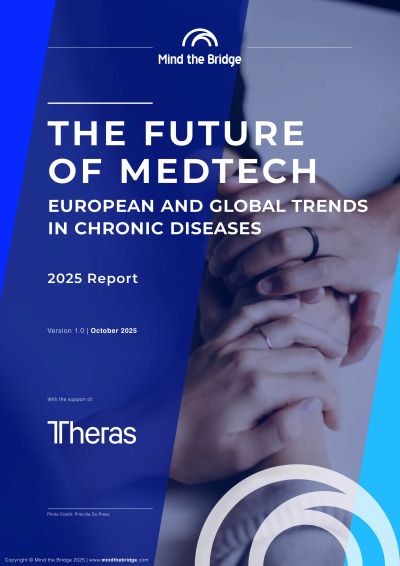The Future of Medtech – European and Global Trends in Chronic Diseases
At Mind the Bridge, we have long observed that the world of innovation remains deeply asymmetric.
The United States continues to dominate global Medtech investment, capturing roughly 80% of total venture capital flows, while Europe, despite representing the world’s second-largest healthcare market, still accounts for a modest 15–20%. This imbalance, however, signals not weakness but opportunity.
Europe’s healthcare landscape is vast, universal, and evolving.
Public health systems covering more than 400 million people spend nearly 10% of GDP on healthcare, creating strong and predictable demand for solutions that enhance efficiency and outcomes.
Chronic and metabolic diseases alone impose an annual cost exceeding €1 trillion, yet access to innovative technologies remains uneven across regions. Bridging this gap, by pairing US innovation with European operational depth, represents one of the most promising growth opportunities of the decade.
Our experience supporting hundreds of scaleups across continents has shown that growing internationally is rarely a matter of technology, it is a matter of “translation”.
This is even more true for Medtech companies where adapting business models, reimbursement strategies, and go-to-market approaches to fit complex local ecosystems is not an option.
In Europe, where regulation and reimbursement vary by country, success depends on finding the right local partner, one that brings clinical credibility, distribution reach, and a deep understanding of national health systems. In this context companies like Theras Group can act as catalysts for global innovation, translating advanced technologies into accessible care for thousands of patients.
That’s what we call the Partner Advantage: the ability to transform innovation into impact through strategic local alliances.
This report, developed by Mind the Bridge with the support of Theras Group, aims to illuminate this opportunity. It maps Europe’s Medtech investment dynamics, quantifies the scale of unmet need in chronic therapeutic areas (metabolic disorders and chronic pain), and outlines the regulatory and operational pathways that startups and scaleups navigate to succeed across European markets.
The message is clear: while the US remains the engine of Medtech innovation, Europe stands as its next frontier of adoption. For startups and scaleups ready to expand beyond borders, and for partners ready to bridge the gap, the time to act is now.
